There are 12 types of turtles and tortoises in California, but only 8 are native species. The rest are alien species that have either made their way into the state or have been introduced by humans.
There are 5 species of sea turtles that frequent California’s waters and some that come ashore and lay their eggs. The Golden State has a wide range of habitats for these turtle and tortoise species so here they are in no particular order:
Table of Contents
Turtles in California
Pond turtles in California
1. Western Pond Turtle

- Experience Level: Intermediate to Expert
- Family: Emydidae
- Scientific Name: Actinemys Marmorata
- Other Names: Pacific Pond turtle, Northwestern Pond Turtle
- Adult Size: Between 4 and 9 inches
- Lifespan: Between 30 and 50 years
- Average Price Range: Around $500 (very rare as they are difficult to breed, and illegal to own in many states)
- Conservation Status: Endangered
There are actually 2 species of Western pond turtle found in California. They are the Northwestern and the Southwestern Pond Turtle. Since they are so similar we grouped them both together, and for this list, count them as a single species.
The western pond turtle can live in most freshwater habitats, including streams, ponds, lakes, creeks, wetlands, or other bodies of water. Although they are not picky about the water they live in, both these species are experiencing serious population declines.
The main causes include loss of habitat and alteration. Meaning they have fewer places to live and because of human intervention, their normal waterways get dammed up, changed, and become polluted.
These turtles also experience low reproduction rates, predation by birds, fish, raccoons, otters, coyotes, and the American bullfrog. Some of these predators will attack nests and eat eggs, while most others will consume baby turtles before their shells have a chance to harden.
The American bullfrog is not native to California, but these voracious frogs will eat anything that moves, and they can stuff into their cavernous mouths.
One last cause of population decline is the introduction of alien species such as the common snapping turtle, and red-eared sliders. These turtles breed faster, and will take over native turtle habitats.
Western Pond turtles have dark skin with lighter spots and blotches. Their upper shell (carapace) is brown or black and has light marbling patterns. The lower shell (plastron) is yellow with black highlights.
These turtles are omnivorous. They will eat tadpoles, insects, and insect larvae, as well as frog eggs, leeches, snails. They also graze on vegetation such as algae, cattail roots, and lily pads.
2. Red-Eared Slider
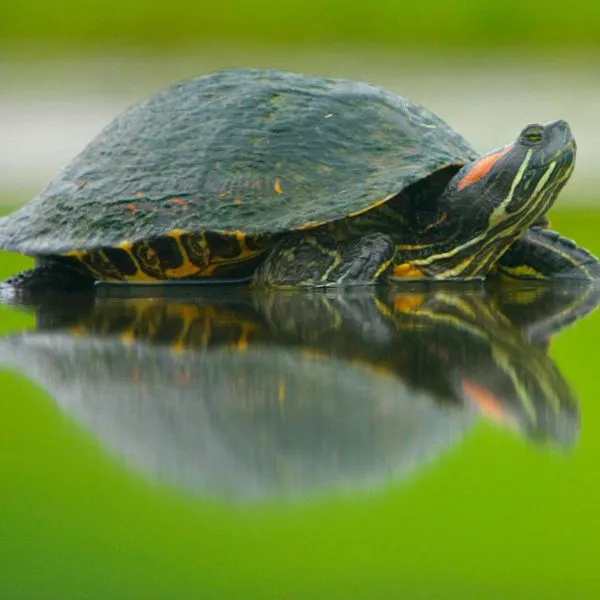
- Experience level: Beginner
- Family: Emydidae
- Scientific Name: Trachemys scripta elegans
- Common Name: Pond slider, Red-eared terrapin, Water slider
- Average Adult Size: 6 – 8 inches
- Life Span: 20 to 40 years
- Average Price Range: approximately $30 to $100
- Conservation Status: Least concern
The red-eared slider is like the western pond turtle’s pushy big sister. They are native to southern and south-eastern states, but are quickly taking over waterways everywhere else.
What’s so bad about introducing turtles into the wild where they don’t naturally live? Well, in the case of the Red-eared slider, they tend to take over. They are prolific breeders, they have big appetites, and will bully other turtles out of their natural habitats.
In the 70s and 80s, red-eared sliders were sold in nearly every store because they were cute and active little pets. It didn’t take long for parents to realize these pets took a lot of time and care. Trying to be helpful to the turtles, they released them into the wild.
If red-eared sliders are anything, they are survivors. Unfortunately, they are harming native turtle populations.
These turtles look very similar to Western Painted turtles. They even have yellow stripes on their dark green to black skin. The big difference is the red “ears” that are found just behind their eyes. These are actual ears but red blotches.
Red-eared sliders will eat nearly anything, and will inhabit most permanent bodies of water, though they prefer slower moving waters.
Mud turtles in California
3. Sonoran Mud turtle
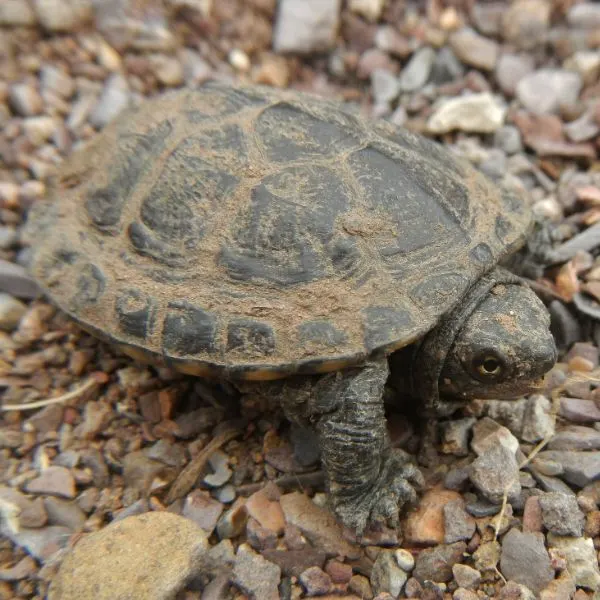
- Experience level: Beginner – Intermediate
- Family: Kinosternidae
- Scientific Name: Kinosternon sonoriense
- Common Name: Sonora Mud Turtle, Mud Turtle, Desert Mud Turtle
- Average Adult Size: 3 – 7 inches
- Life Span: 40 years
- Average Price Range: Approximately $200 and up
- Conservation Status: Endangered
These tiny aquatic turtles were once abundant along the Colorado River and in ponds, slow moving streams, and oxbows. Now though it’s thought they are extinct in the state.
They live sedentary lives in the water and are difficult to track and count. They stay mostly in the water but will travel long distances to find another suitable habitat.
These turtles don’t get very large. Females max out at around 6 or 7 inches long, while males are slightly smaller. They have light markings on their heads, and mottled colorations on their heads, necks, and limbs.
They have a hinged shell, an olive to dark brown carapace with marked seams along the scutes. Their plastron is yellow to brown and it too has dark seams.
The Sonoran Mud turtle is usually active in the daytime until the temperatures reach triple digits. Then they tend to become more nocturnal.
They are omnivorous and will feed on snails, small fish, tadpoles, insects, and some vegetation.
Painted turtles in California
4. Western Painted Turtle
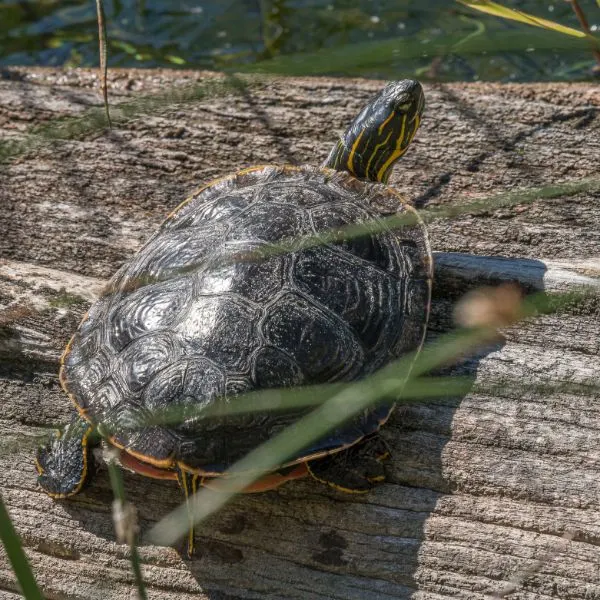
- Experience Level: Beginner
- Family: Emydidae
- Scientific Name: Chrysemys Picta Belli
- Other Names: N/A
- Adult Size: Between 4 and 10 inches
- Lifespan: Between 30 and 50 years
- Average Price Range: Between $30 and $150
- Conservation Status:
The western painted turtle is another non-native species, although they aren’t quite as prolific as the Common Snapping turtle or the Red-eared Slider. These turtles have bright yellow stripes along their heads, necks, and legs.
Their carapace is mostly dark colored, although younger turtles may have some markings. The plastrons are reddish orange, with darker, intricate markings.
Though they spend most of their time in the water, and even sleep at the bottom, they do love to bask in the sun on warm days. Sometimes multiple turtles will crowd a small log or bank to get the best basking spot.
Western Painted turtles will eat nearly anything, and will often leave the water in search of food. They eat vegetation, insects, snails, worms, fish, carrion, tadpoles, and whatever else they can get.
Softshell turtles in California
5. Texas Spiny Softshell
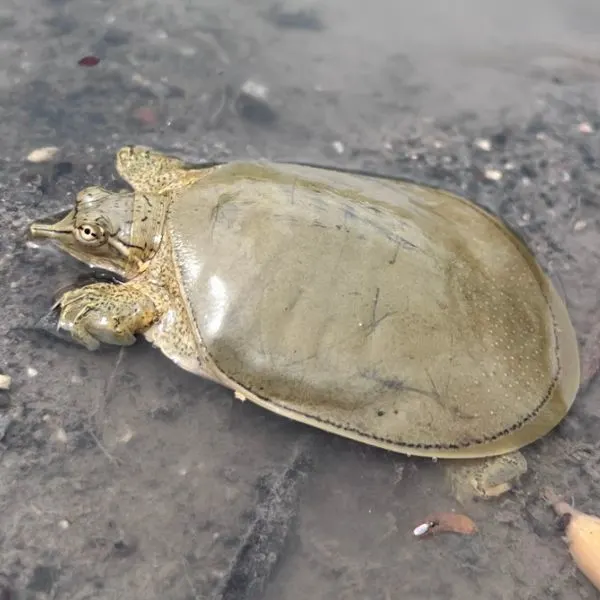
- Experience level: Intermediate to Expert
- Family: Trionychidae
- Scientific Name: Apalone spinifera emoryi
- Common Name: Spiny Softshell Turtle
- Average Adult Size: 5 – 17 inches
- Life Span: 40 – 60 years
- Average Price Range: Approximately $50 – 280
- Conservation Status: Least Concern
The Texas Spiny Softshell turtle is a transplant from Texas and New Mexico. It’s a subspecies of the spiny softshell turtle. Although they come from Texas, they aren’t the biggest softshell turtle. (Hey wait a minute, I thought everything was bigger in Texas!)
They are usually dark brown, grey, or olive colored with darker spots that tend to fade with age. On their skin they may have lighter stripes or other types of markings. Their shells are leathery or rubbery and soft.
Because they don’t have the protection of a hardened shell, these turtles have a bad attitude out of the water and won’t hesitate to hiss and bite. They have sharp beaks that will easily pierce skin, so do not approach them out of the water.
Most likely they will run away before you can get close. Believe it or not, softshell turtles are very quick on land, and quite accomplished swimmers in the water.
Texas Spiny Softshell turtles are omnivorous, but they prefer to eat meat. This includes fish, frogs, insects, carrion, snails, and nearly anything they can get into their jaws.
Snapping turtles in California
6. Common Snapping Turtle
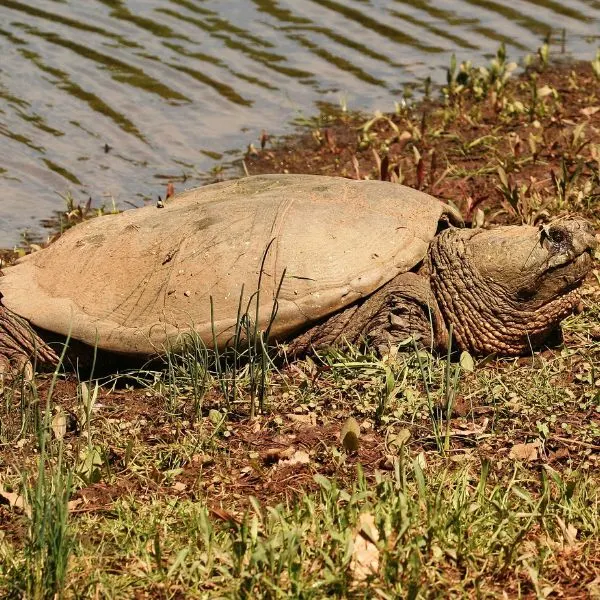
- Experience level: Intermediate to Expert
- Family: Chelydrida
- Scientific Name: Chelydra Serpentina
- Common Name: Common Snapping Turtle, Snapper, Eastern Snapping Turtle
- Average Adult Size: 8 to 20 inches
- Life Span: 30 – 50 years
- Average Price Range: Approximately $40 to $120
- Conservation Status: Least concern
The Common Snapping turtle is native to the eastern US, but they are encroaching in habitats all over the United States. This is probably because owners are releasing them into the wild when they realize they can’t care for them.
Snapping turtles can get very big, and will live for a very long time. With an average weight of 35 pounds and growing as long as 20 inches, they can get bigger than many dogs.
Common snapping turtles aren’t picky about where they live, or what they eat. They will gladly snack on anything from insects to fish, and on rare occasions, small birds. Most of the time though, these portly turtles resort to ambush hunting.
Their carapace is thick, dark green, brown, or black, and doesn’t cover the entire turtle. The plastron is usually white or cream colored and is even smaller, only covering very little of the turtle.
Initially they are shy in the water, but they can have a bad attitude out of the water. While there have not been any recorded instances of amputation from their strong bites, they have enough bite force to break bones.
Tortoises in California
7. Agassiz’s Desert Tortoise

- Experience level: Beginner
- Family: Testudinidae
- Scientific Name: Gopherus agassizii
- Common Name: Mojave Desert Tortoise
- Average Adult Size: 9-15 inches
- Life Span: 50 – 80 years
- Average Price Range: Illegal to purchase a desert tortoise–Must be adopted
- Conservation Status: Vulnerable
Aside from California, the desert tortoise is also native to Arizona, Utah, Nevada, and northern Mexico. It’s illegal in California to own a desert tortoise without a special permit. Otherwise you’re not supposed to mess with them in any way.
They are threatened or endangered in much of their natural habitat. Much of their population decline is because of habitat loss, motor vehicle accidents (off road vehicles in particular) and the introduction of roads through their normal habitat.
These tortoises are important for vegetation seed dispersal, and because of the burrows they dig. Desert tortoises will dig several burrows throughout their lives, which become dens for other animals such as peccaries, gila monsters, roadrunners, and burrowing owls.
The desert tortoise has a thick, high domed shell that is mostly devoid of any markings. Their shells are usually brown, tan, or grey, and their skin is brown or tan. They have thick, raised scales on their forelimbs that help them dig.
Desert tortoises are herbivores. They eat cacti, flowers, grasses, and a wide array of other vegetation. They don’t typically drink water as they get most of their moisture needs from the foods they eat.
When it rains though, the desert tortoise may drink from puddles or soak in them to help cool off.
Sea Turtles in California
8. Loggerhead Sea Turtle
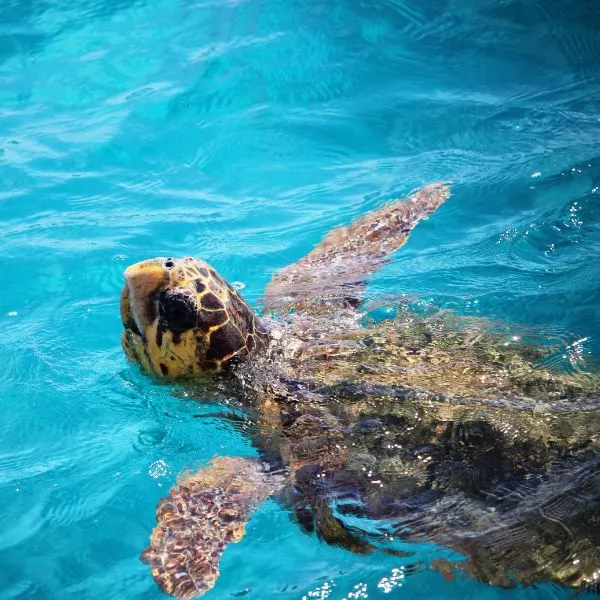
- Experience Level: N/A, Illegal to own any sea turtle
- Family: Cheloniidae
- Scientific Name: Caretta Caretta
- Other Names: Loggerhead
- Adult Size: 2.5 – 3.5 feet
- Lifespan: 70 – 80 years
- Average Price Range: N/A
- Conservation Status: Endangered
The loggerhead sea turtle is the largest hard-shelled turtle in the world, with some of its biggest specimens recorded having shells 7 feet long and weighing more than 1,000 pounds. Turtles this big rarely exist any more, and most loggerhead turtles are around 3 to 4 feet long.
All sea turtles are listed as threatened or endangered. Sea turtles face numerous threats to their survival, the biggest being pollution and fishing nets.
Though loggerhead sea turtles can sometimes be seen off the coast of California, they nest along the Atlantic region. They return to the nest they were born from using geomagnetic imprinting. Meaning they use the earth’s geomagnetic field to find their way back to the same beach they hatched from.
Loggerhead sea turtles have huge jaw muscles. They need these knots of muscle to crack open clams, whelk shells, and horseshoe crabs which they eat. Jellyfish, sea squirts, barnacles, fish, and some vegetation also comprise their diet.
9. Green Sea Turtle
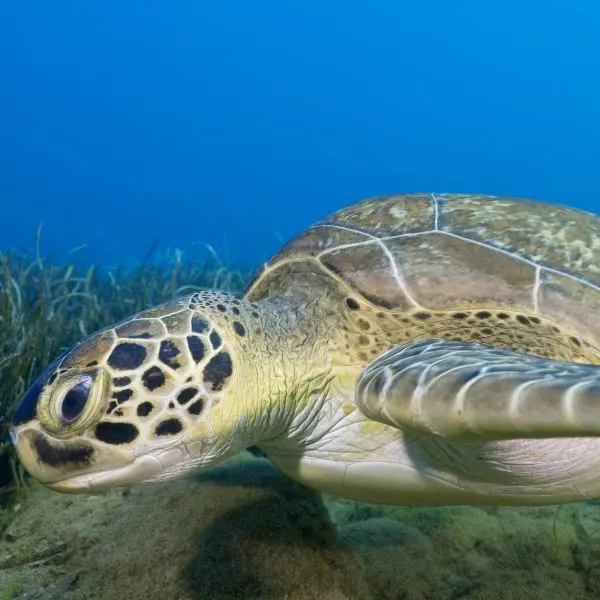
- Experience level: N/A, Illegal to own any sea turtle
- Family: Cheloniidae
- Scientific Name: Chelonia mydas
- Other Names: Green Sea Turtle
- Average Adult Size: 3 – 4 feet
- Life Span: 50 – 70 years
- Average Price Range: N/A
- Conservation Status: Endangered
Disappointingly, green sea turtles aren’t too green – greenish at best. Actually, the green in the name comes from the color of the fat under their carapace. This green color comes from the algae that they eat, as this is mostly what they feed on as adults.
As babies, they feed on insects, worms, and other small animals, but switch to a plant-based diet once they grow over 8-10 inches in length. They probably need a lot of protein while they’re growing up very quickly.
This turtle is the only sea turtle observed sunbathing on beaches. They tend to prefer Hawaiian beaches the most because this is the only place where they are observed nearly on a daily basis. Ah, what a life!
Female lays eggs every other year, but will lay multiple clutches per season, with an average of over 100 eggs every time. Despite this, the number of green sea turtles around the world is dropping rapidly. Most baby turtles never reach adulthood; it’s thought that only 1 in 1,000 actually grow to become adults.
10. Hawksbill Sea Turtle
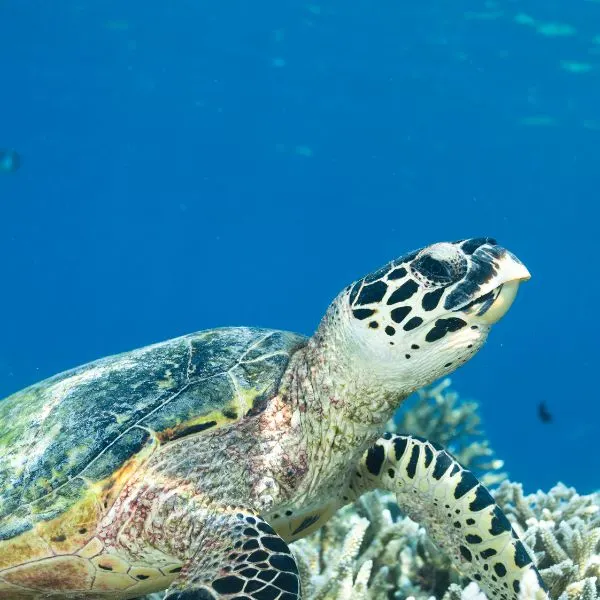
- Experience level: N/A, Illegal to own any sea turtle
- Family: Cheloniidae
- Scientific Name: Eretmochelys imbricata
- Other Names: Hawksbill
- Average Adult Size: 30 – 36 inches
- Life Span: 50 – 60 years
- Average Price Range: N/A
- Conservation Status: Critically endangered
The hawksbill sea turtle is very easily recognizable – it has a beak-like mouth (hence the name) and beautiful patterns on the shell and legs. They have dark brown to black scales outlined in white. Their shells have radiating marbled patterns across their scutes.
Unfortunately, this breathtaking beauty has made them a desirable target for the illegal tortoiseshell market. They have been protected since 1977, but people still harvest them solely for the shell to make combs, glasses, guitar picks, and other useless items.
This species tends to stick close to the coast because that’s where they can find their favorite snack – sponges. However, they’ll also eat algae, jellyfish, fish, squid, and shrimp.
Hawksbill turtles will nest in California so be careful when you’re on the beach during the nesting season (August through November). They also nest along tropical shores such as Mexico, Hawaii, and Central America.
The hawksbill sea turtle nests approximately every 2 to 4 years, but will lay multiple clutches per season (usually 3-6). Each nest averages between 50 to 200 eggs, which take around two months to hatch.
Baby turtles emerge to face a gauntlet of hungry crabs, seagulls, dogs, raccoons, and other predators to get to the water. There fish, octopus, and others still feed on the tiny turtles. That’s if the nests haven’t been robbed by humans.
11. Olive Ridley Sea Turtle
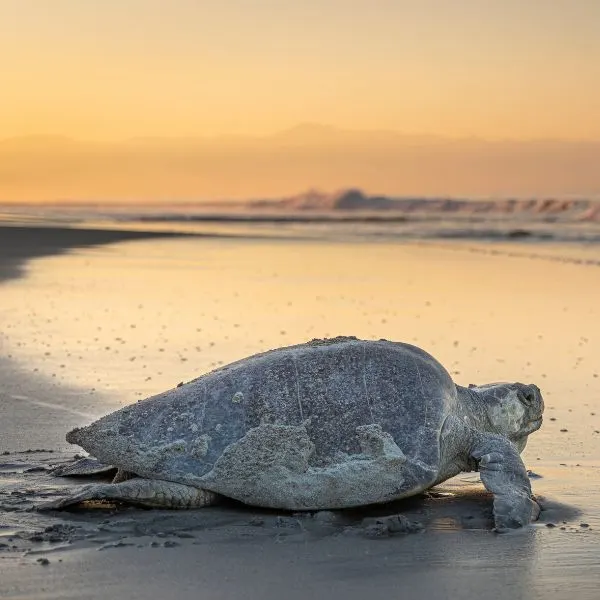
- Experience level: N/A, Illegal to own any sea turtle
- Family: Cheloniidae
- Scientific Name: Lepidochelys olivacea
- Other Names: Ridley sea turtle
- Average Adult Size: 20 – 29 inches
- Life Span: 40 – 50 years
- Average Price Range: N/A
- Conservation Status: Threatened
Unlike green sea turtles, the Olive Ridley sea turtle did get its name from the color of its skin and carapace. They are the smallest and most numerous sea turtles, yet they are still listed as threatened.
They only grow about 30 inches long, and have heart-shaped, green shells. There is not much information on the Olive Ridley sea turtle because they have such long migratory patterns.
They are somewhat omnivorous, but prefer to eat crustaceans, jellyfish, crabs, sea urchins, and snails.
Though they may be seen floating on the surface around California, they typically nest in more temperate waters such as Mexico, Central America, India, and around Oceania.
A unique nesting ritual practiced by these turtles might be the key to their survival. Namely, they practice “arribada” nesting. This is a synchronized nesting effort where huge numbers of turtles come to shore and nest at the same time. When the baby turtles hatch, it’s such a massive migration that many more babies seem to survive the early predatory onslaught.
12. Leatherback Sea Turtle
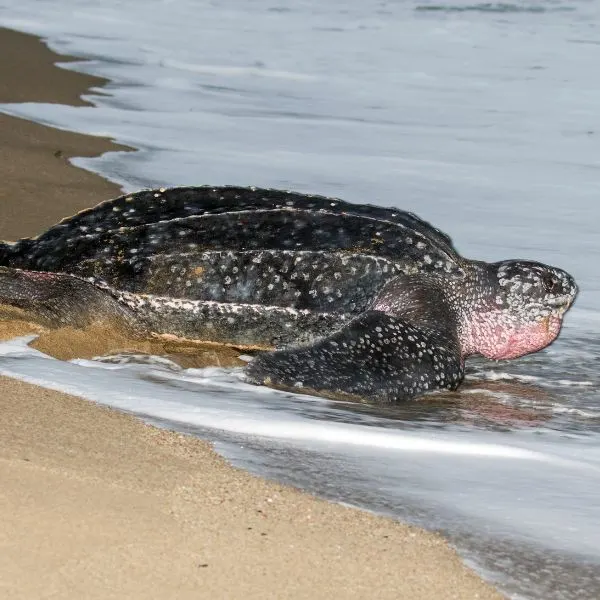
- Experience level: N/A, Illegal to own any sea turtle
- Family: Dermochelyidae
- Scientific Name: Dermochelys coriacea
- Other Names: Atlantic Leatherback, Leatherback
- Average Adult Size: 4 – 8 ft
- Life Span: 30 – 50 years
- Average Price Range: N/A
- Conservation Status: Endangered
Leatherback sea turtles are the largest turtles on the planet, and they are the only sea turtle without a hard shell. Their back is covered in numerous, small, bony plates, covered with a black, leathery skin.
The leatherback sea turtle can reach lengths of over 7 ft long, and weigh as much as a small car. (Almost a ton.)
Not only are they the largest, but they are also the most migratory sea turtle species. They have been recorded in the cold Alaskan and Norwegian waters and as far south as the southern tip of Africa, New Zealand and southern Australia.
They are great swimmers and can dive deeper than any other sea turtle. Oh the sights these turtles must be able to see. They can dive up to 4,000 feet deep, and even stay there for well over an hour.
This sea turtle has a voracious appetite for jellyfish. It’s nearly the only thing they eat, occasionally they will snack on sea squirts or sea cucumbers, but mostly the watery jellyfish.
They have to eat A LOT of jellyfish to get all the calories they need. Especially since jellyfish are nearly 90% water. The leatherback sea turtle needs to consume around 10,000 to 16,000 calories per day.
That equals over 600 lions mane jellyfish every single day! These are the biggest jellyfish in the ocean and average about 2 feet in diameter, with the largest ones reaching nearly 7 feet in diameter. That’s as big as a full grown leatherback.
That’s why I stay out of the water.
FAQ’s
How do you adopt a Californian desert turtle?
The adoption process can be started by getting in touch with the California Turtle & Tortoise Club. This can be done online. You require a license to keep a desert tortoise in California. This is because these tortoises are endangered. Relevant links include California Turtle & Tortoise Club, California Department of Fish and Wildlife (CDFW), and Desert Tortoise Application (PDF Form).
What other tortoises should I consider as pets if I live in California?
California is a large place with a variety of climates, however, most regions of California (especially southern California) are relatively warm and dry.
This climate makes California ideal for a wide variety of Mediterranean tortoises and Sub-Saharan tortoises. Great examples of Mediterranean tortoises include the Greek tortoise and Hermann’s tortoise. The Sulcata tortoise is an excellent example of a Sub Saharan tortoise, but keep in mind, these tortoises can get very large and live for nearly 100 years.
Can you catch a wild turtle and keep it as a pet?
While it’s tempting to “save” a wild turtle from a tough life of dodging cars and predators, it’s best to leave wild turtles alone. In some instances it’s highly illegal to take wild turtles from their habitat. Not to mention, the stress could injure or even lead to its demise.
If you want a pet turtle, find a reputable breeder that has captive bred turtles, or adopt a turtle from rescue agencies. Do your research first, turtles may seem like simple pets, but they actually require a lot of care.
Should I move wild turtles or put them back in the water?
When you see a turtle in the wild, simply observe it as it is and leave it alone. You don’t have to put turtles back in the water. Many times turtles leave the water to find a mate, find food, look for a new place to live, or bask in the sun.
Turtles on the road can be moved for their safety, just make sure you’re safe as well. Wild turtles can bite and cause painful injuries. Also keep in mind where the turtle was headed. If you take a turtle from the road and face it the opposite direction, it will turn itself around and continue in its original heading. Meaning it will attempt to cross the road again.
Conclusion
Turtles are not an uncommon occurrence in the state of California. There are about a dozen different species and subspecies, all with their unique characteristics, habits, diets, and habitats.
When you see turtles in the wild, leave them be, they just want to do “turtelly things” and live their best reptilian lives. If you have a turtle that you can no longer care for, don’t release them in the wild, they can spread disease and harm native species. Take them to a rescue or find someone else to adopt them.
Hey there! We love to hear from you! So why not drop us a comment below. Tell us where you’re from, what you love the most about turtles, or share a story about turtles.
Other nearby states
